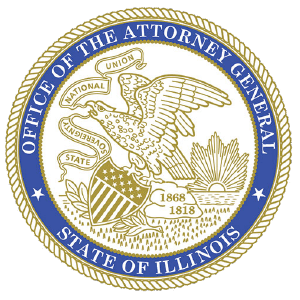Data Analysis of Priests and Brothers Substantiated as Child Sex Abusers Associated with the Illinois Dioceses
Here, the Attorney General uses statistical methods to contextualize the span of time Catholic priests and religious order brothers who sexually abused children were associated with an Illinois diocese, as compared with the total number of all priests and brothers associated with an Illinois diocese during that same period. Although the Attorney General names 451 individual clerics and brothers as substantiated child sex abusers across the State, in this analysis, that number is considered in light of how many total priests and brothers were associated with an Illinois diocese at any given time, and how long abusers remained priests or brothers. This analysis also localizes abuser data by diocese and year in order to reveal the risk children faced when encountering a Catholic priest or brother associated with each Illinois diocese over time. The longer an abuser was a priest or brother, the longer they could take advantage of the unique access and power afforded Catholic clerics and religious brothers to sexually abuse children.
Data science expert Dr. Greg Ridgeway reviewed data compiled by the Attorney General and applied statistical methods to that data to generate the graphs in this section. Dr. Ridgeway is Professor and Chair of Criminology and Professor of Statistics and Data Science at the University of Pennsylvania. Dr. Ridgeway’s research involves the development and application of statistical methodologies for answering questions about crime and the criminal justice system, including guns, drug policy, policing, and fairness in the justice system. Previously, Dr. Ridgeway was the Acting Director of the National Institute of Justice, the U.S. Justice Department’s science agency. Before joining the Department of Justice, Dr. Ridgeway directed RAND’s Safety and Justice Research Program and RAND’s Center on Quality Policing, managing RAND’s portfolio of work on policing, crime prevention, courts, corrections, and public and occupational safety. Dr. Ridgeway is a Fellow of the American Statistical Association and in 2007, received the ASA Outstanding Statistical Application Award for his development of methods for assessing racial profiling. He is Co-Editor-In-Chief of the Journal of Quantitative Criminology. He received a Ph.D. in statistics from the University of Washington, Seattle.
Attorney General investigators collected two categories of data for Dr. Ridgeway’s review and analysis:
- The total number of Catholic priests and brothers associated with each Illinois diocese in each year from 1950 to 2019; and
- The number of Catholic priests and brothers who have been substantiated as child sex abusers and were associated with an Illinois diocese in each year during that period.
Attorney General investigators collected this data entirely from Catholic sources. A priest or brother is counted as associated with an Illinois diocese whenever church authorities counted them in the personnel statistics for the diocese.
A key resource for compiling this data was the Official Catholic Directories (“Directories”). The Directories “contain[] ecclesiastical statistics of the United States.” They have been published annually “giving the status of the Catholic Church as of January 1” of the issued year. For example, the 2019 Directory contains the status of Catholic priests, bishops, religious brothers and sisters, schools, parishes, and other entities as of January 1, 2019.
Who Was Counted as Associated with Each Illinois Diocese
The Directories include three categories of priests or brothers in the personnel statistics for each Illinois diocese.
First, a local diocesan priest, meaning one ordained in the local Illinois diocese. A local diocesan priest typically ministers in their own diocese (e.g., a priest ordained in the Diocese of Springfield usually ministers within the territory of the Diocese of Springfield). However, a local diocesan priest can also minister outside of their diocese at the behest of their bishop. For instance, a diocesan priest ordained in the Diocese of Rockford could minister in Colombia upon receiving permission from the Rockford bishop, and the bishop would still count that priest as a Rockford diocesan priest in the Directories and have authority over them. Each diocese sums all local diocesan priests in its ecclesiastical statistics, which includes local diocesan priests who are active in the diocese or outside the diocese, in foreign missions, retired, sick, and absent.
Second, an extern priest, meaning a diocesan priest ordained outside the local diocese who is working within it (e.g., a priest ordained in the Archdiocese of Boston ministering in the Diocese of Joliet).
Third, a religious order priest or brother ministering in the diocese with the permission of the bishop (e.g., a priest ordained in the Oblate religious order ministering in the Diocese of Peoria with the permission of the Peoria bishop).
In all three instances, the diocese has counted the priest or brother in their ecclesiastical statistics for the Directories as part of their diocese, presumably because they are either ministering within diocesan boundaries or acting as a diocesan representative outside of those boundaries. A layperson who has encountered these priests and brothers has likely thought of them as a “Chicago priest” or “Belleville priest” who reports to the Chicago archbishop or Belleville bishop regardless of whether they were actually ordained in the Archdiocese of Chicago or Diocese of Belleville. This situation played out consistently in the Attorney General’s investigation, as reports of child sex abuse by a priest or brother in any of the above three categories were almost always made directly to the local diocese.
Illinois Dioceses have excluded cardinals, auxiliary bishops, retired bishops, and deacons from their statistics for total clerics in their diocese in the Directories. Accordingly, they are excluded from this data analysis as well.
When a Priest or Brother Was Deemed Associated with an Illinois Diocese
For local diocesan priests, we counted them as associated with their diocese starting with and including the year of their ordination because for at least one day in their ordination year, they were a local diocesan priest. We then counted them as associated with their diocese for every year after ordination, up to and including the year they: (1) were laicized; (2) died; (3) were ordained in another diocese or a religious order; or (4) were last listed in the Directories, which we took as the last year they were a priest or brother.
For extern priests and religious order priests and brothers, we counted them in our data analysis as associated with an Illinois diocese for every year in which they had a professional assignment—according to a Catholic source—in that diocese. For example, if a Catholic source showed that a priest in the Carmelite religious order had a professional assignment in the Diocese of Springfield from 1955 to 1958, then we counted them as associated with the Diocese of Springfield in 1955, 1956, 1957, and 1958.
Total Priests and Brothers Associated with Each Illinois Diocese in Each Year
The data regarding the total numbers of priests and brothers in each diocese came entirely from the Directories. The Directories break down ecclesiastical statistics by diocese. Each diocese’s section in the Directories begins with a “statistical overview” that includes totals for “personnel” within that diocese. The yearly personnel totals contain the following: (1) local diocesan priests active in the diocese or outside the diocese, in foreign missions, retired, sick, and absent; (2) religious priests in the diocese; (3) religious brothers in the diocese; and (4) extern priests in the diocese. We added these four numbers, and that sum constituted the total priests and brothers associated with the diocese for each year.
Priests and Brothers Substantiated as Child Sex Abusers Associated with Each Illinois Diocese in Each Year
The data regarding the number of priests and brothers who are substantiated child sex abusers were derived entirely from this report’s list of substantiated abusers for each Illinois diocese. Substantiation as a child sex abuser is retroactive. Meaning that it does not matter when the abuse occurred, or if the priest or brother was alive at the time of substantiation; their entire career as a priest and/or brother is counted in this analysis. Further, this report’s lists of abusers reflect all known substantiated abusers as of publication; however, this data would change to the extent more priests and brothers are substantiated as child sex abusers.
Total Number of Substantiated Abusers by Year
This graph reveals the total number of priests and brothers who are substantiated child sex abusers and were associated with an Illinois diocese in each year from 1950 to 2019. The graph shows, in retrospect, how many substantiated abusers were associated with an Illinois diocese as priests or brothers in each year. The total number of priest and brother child sex abusers peaked in 1984 with a total of 211. Most of the abusers were local diocesan priests, averaging about 77% of all priests and brothers that were abusers.
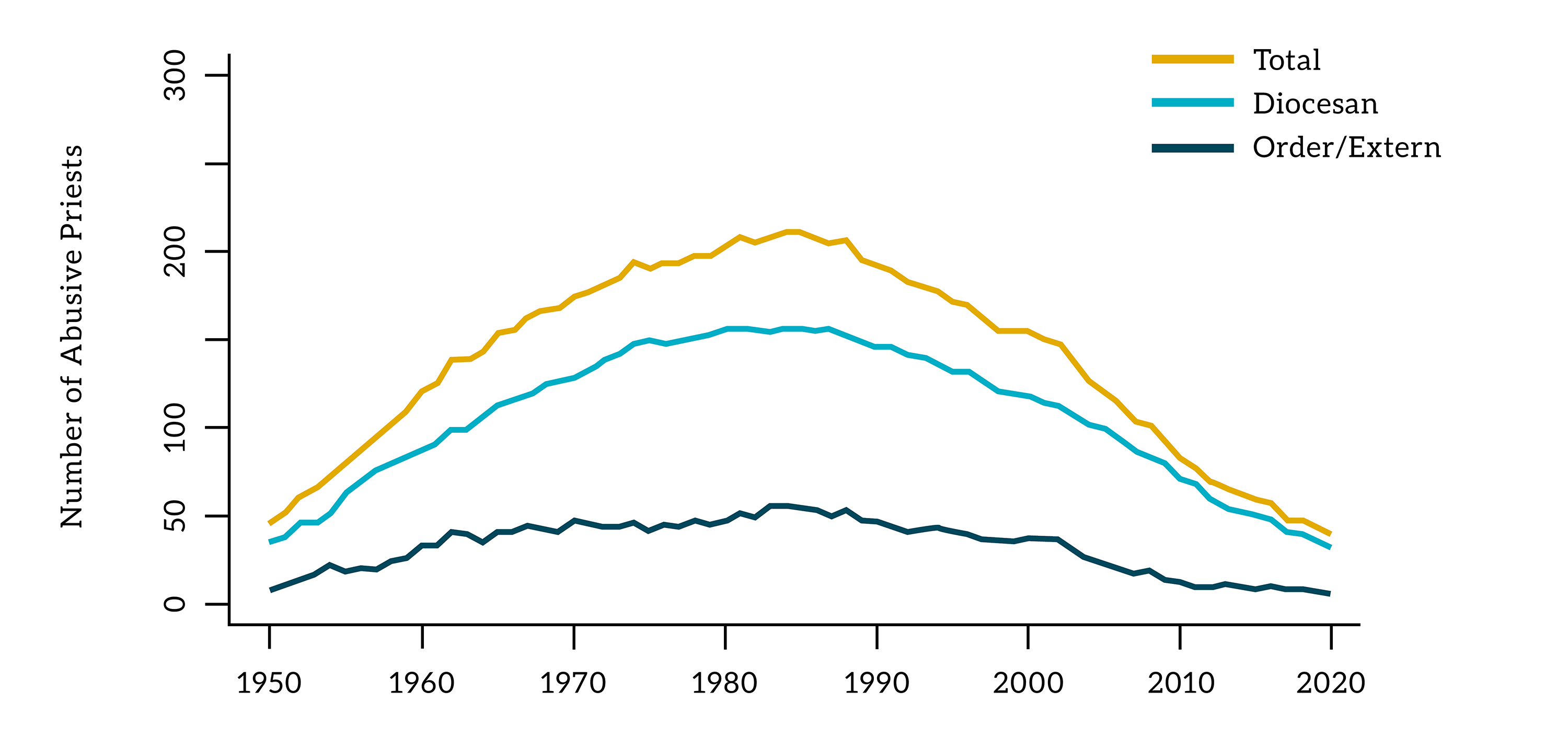
The graph below breaks down by diocese the number of priests and brothers who are substantiated child sex abusers and were associated with the diocese in each year. It reveals that the Archdiocese of Chicago—with the largest Catholic population of all Illinois Dioceses—had the majority of Illinois’ priest/brother abusers. Even so, by 2015, the number of abusers for the Archdiocese of Chicago was reduced to be similar to the other Illinois Dioceses.
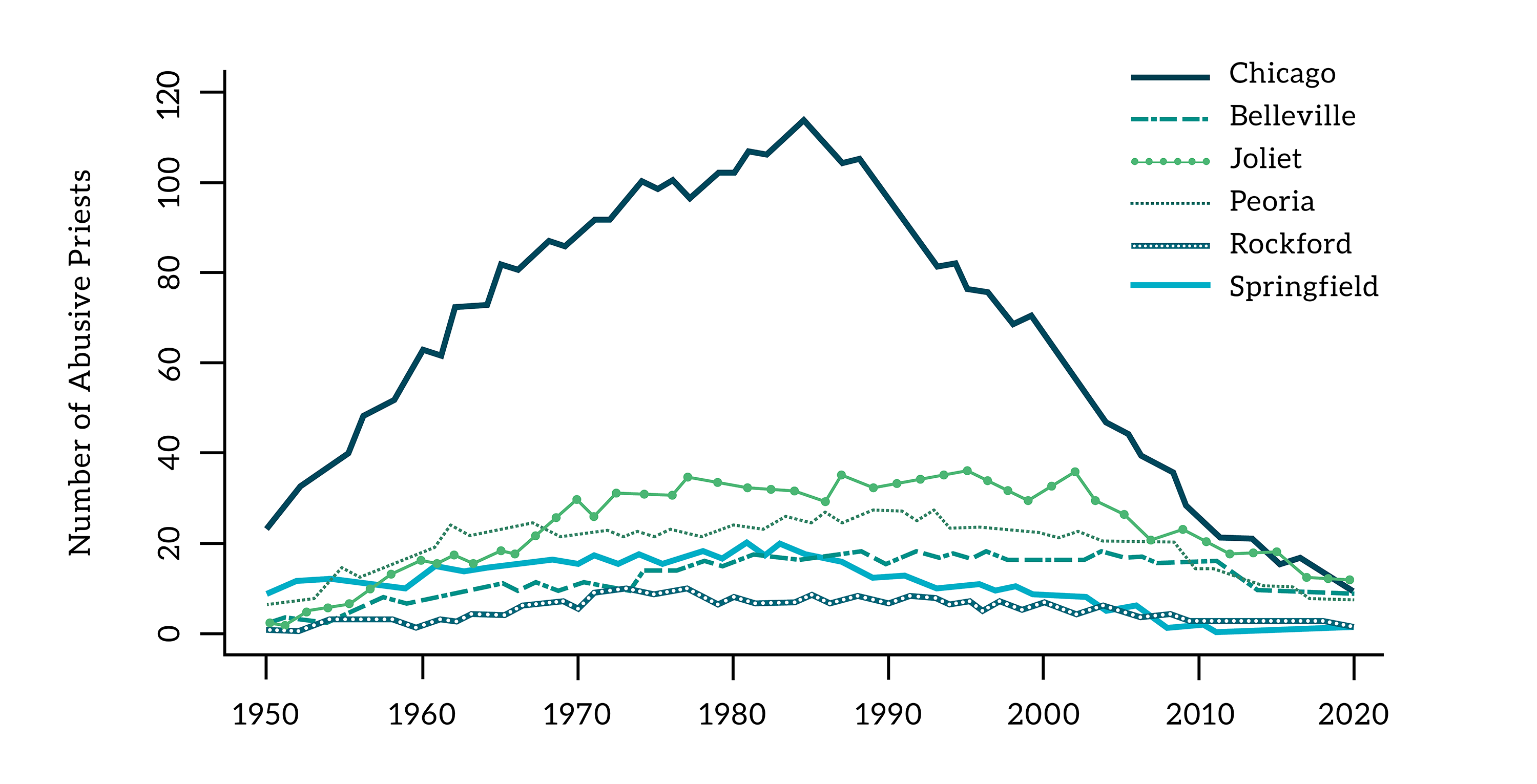
The six graphs below separate the above figure for each diocese. These graphs also identify the tenures of bishops in charge of each diocese from 1950 to 2019. The bishop tenures were included because this report extensively details how failures in leadership by a bishop on the issue of clerical child sex abuse are associated with a greater risk of abuse for the children of that diocese. The graphs below reflect the data outcomes of each bishop’s approach to child sex abuse by clerics and religious brothers, at any given time.

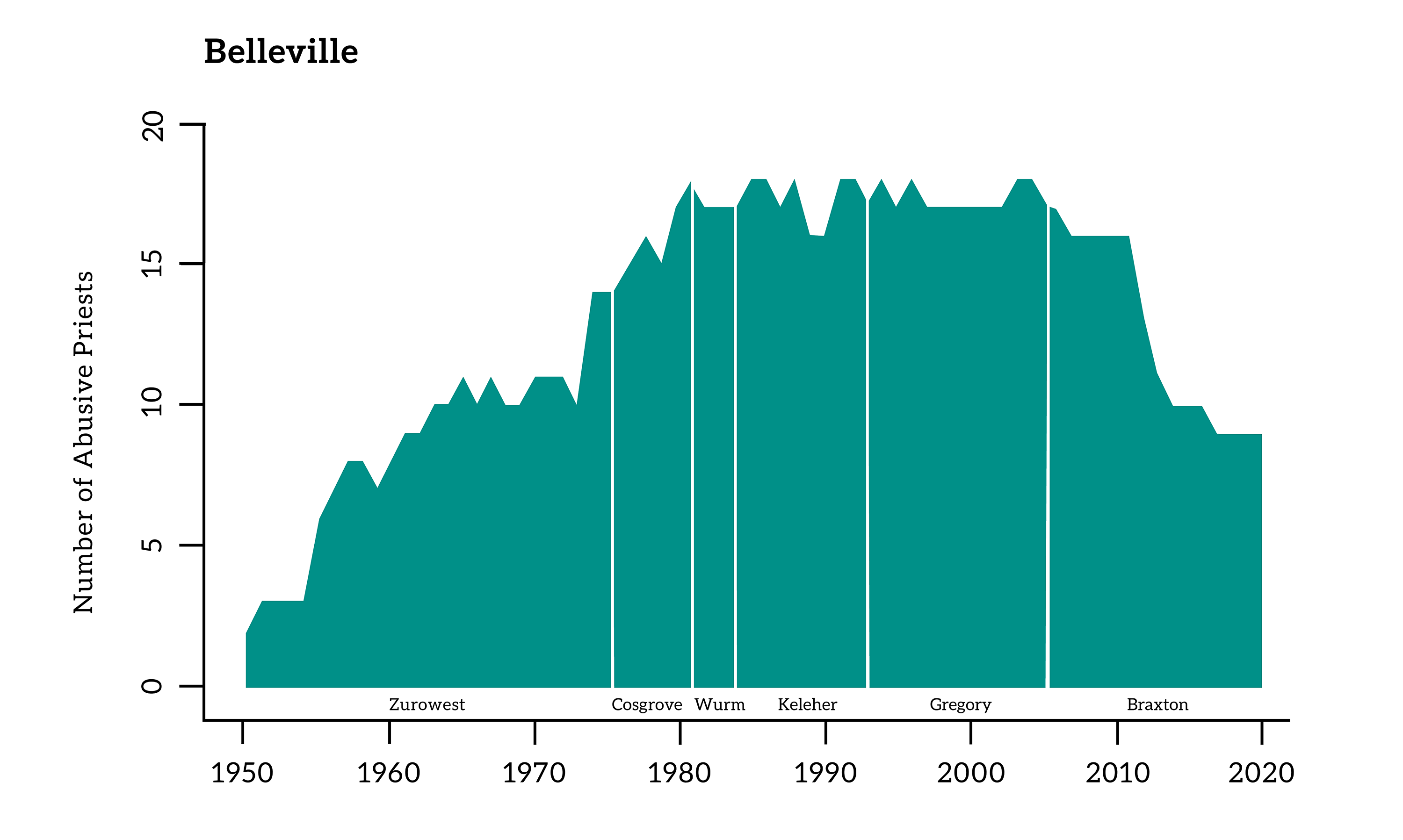
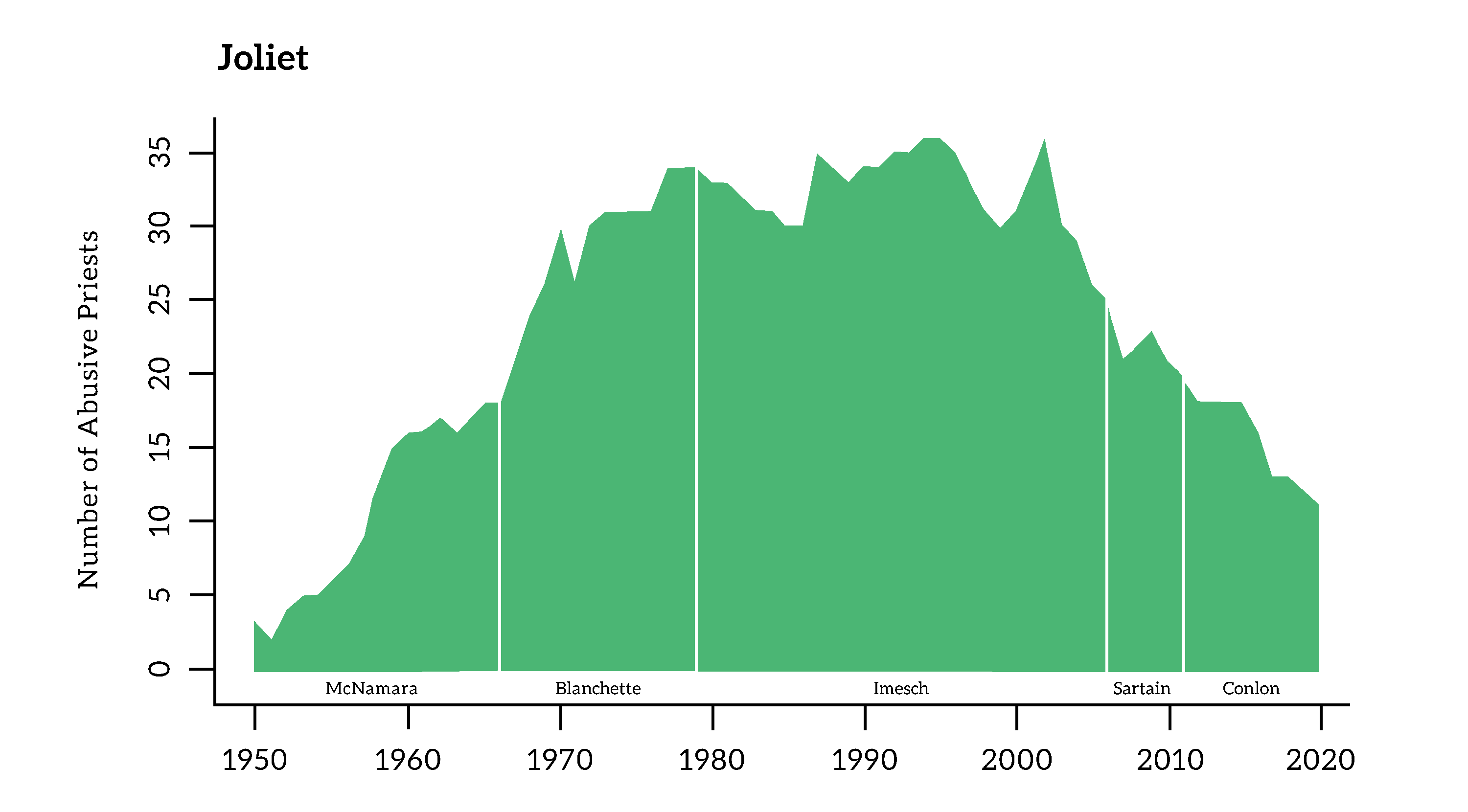
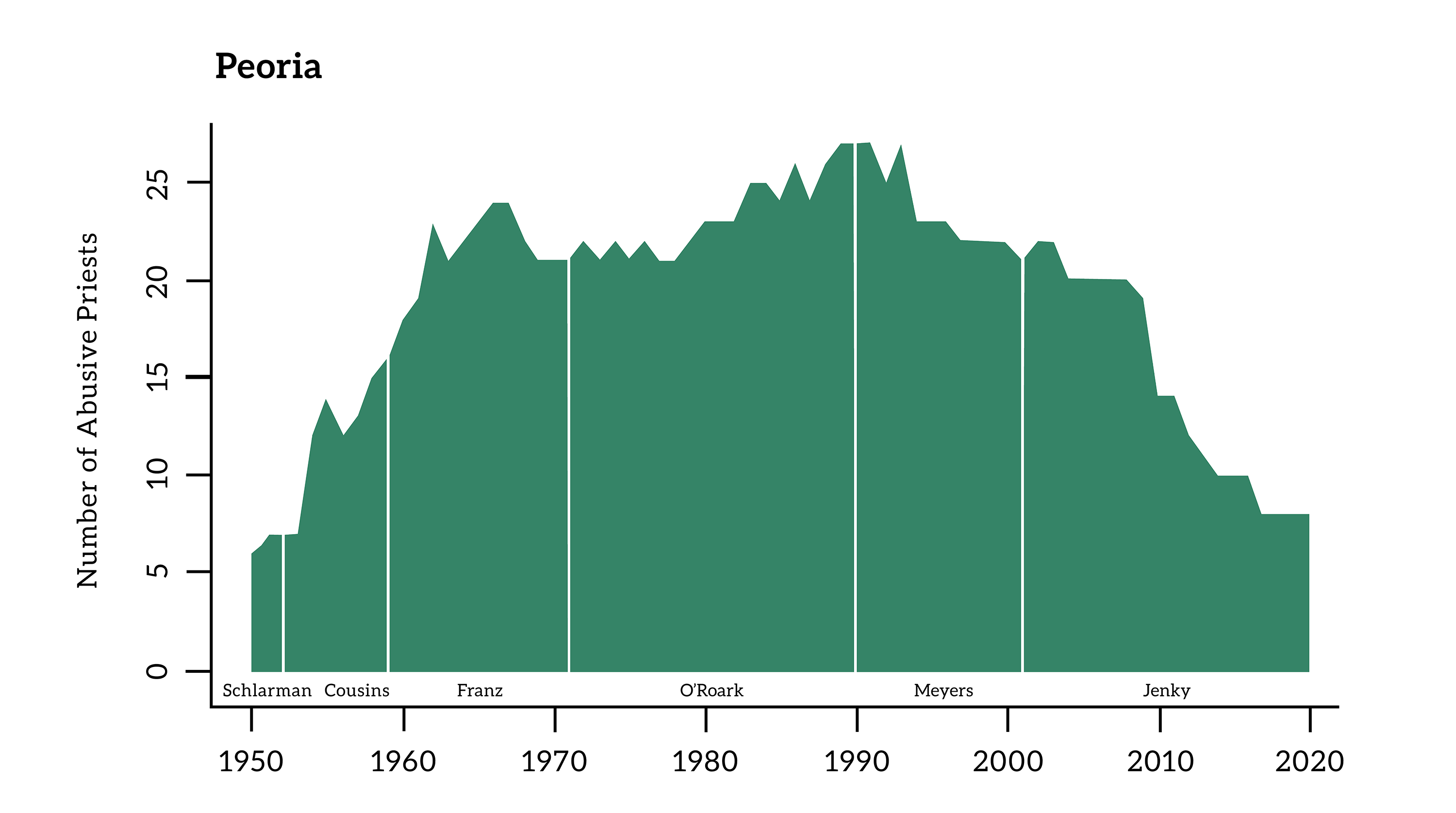
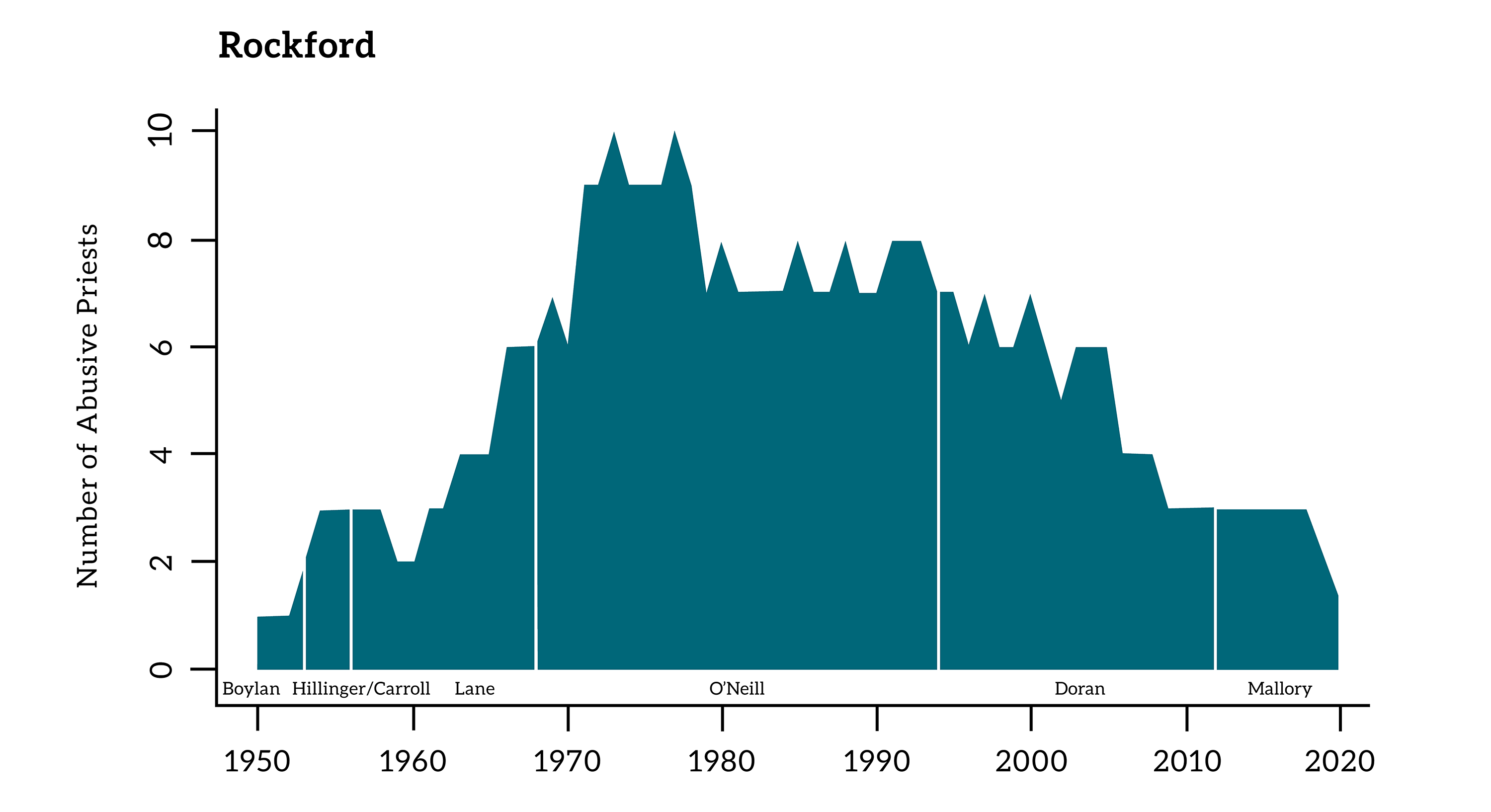
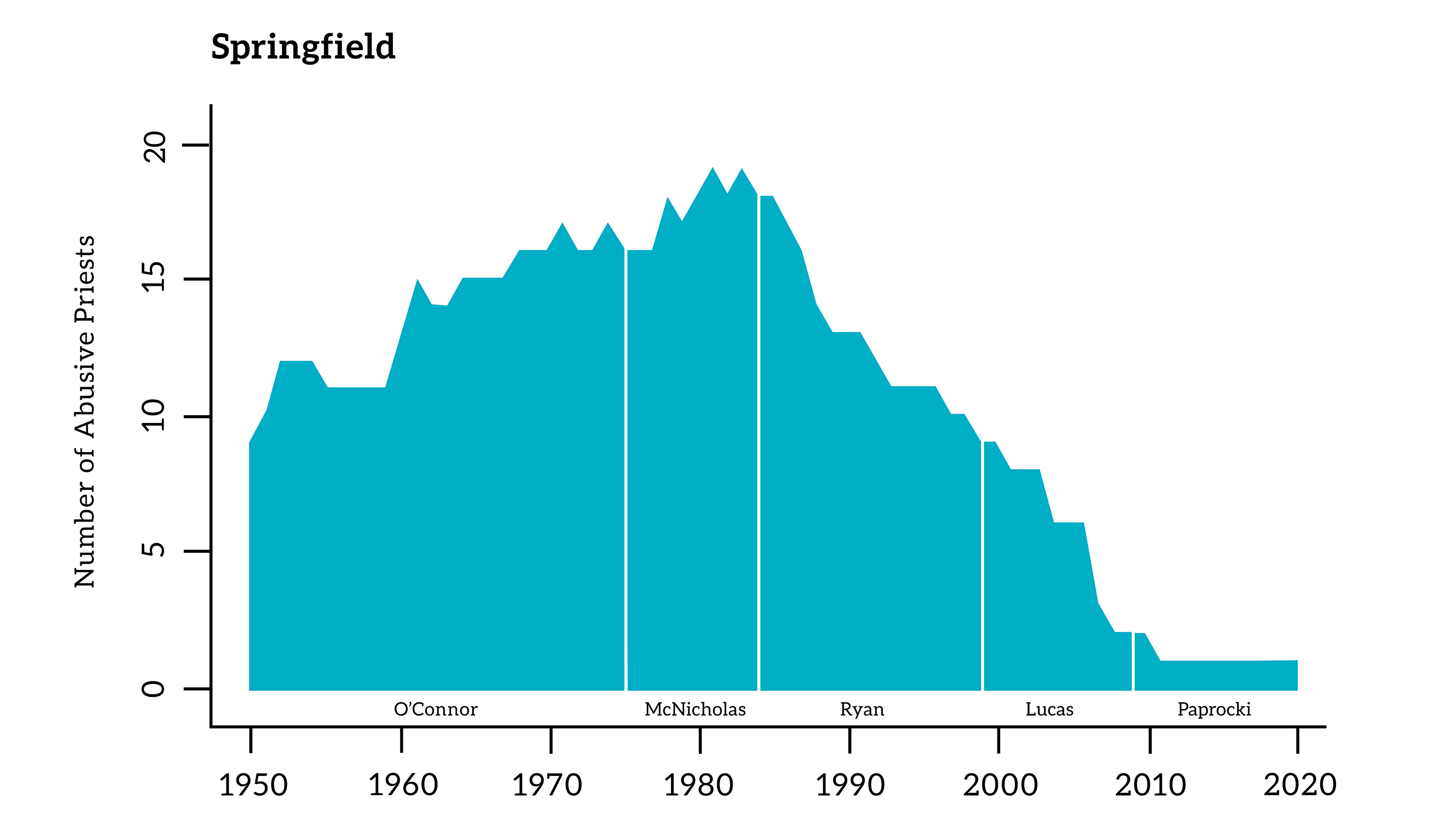
Cumulative Years of Abuse Opportunities for Substantiated Child Sex Abusers
The first graph below shows Illinois’s cumulative years of opportunity for abuse by priests and brothers who are substantiated child sex abusers from 1950 to 2019. Cumulative abuse opportunity helps convey the impact of abusers with long careers as priests or brothers. For instance, an abuser who was a local diocesan priest for 40 years is counted not simply as one in the total, but instead each of their 40 years as a local diocesan priest is counted for the purpose of depicting Illinois’s exposure to them as a child sex abuser with the unique access and power of a priest. By 2019, Illinois had accumulated 9,726 years of abuse opportunities for child sex abusers. The graph also separates the cumulative years of abuse opportunities by priest/brother category with 7,453 years of abuse opportunities for local diocesan priests that are substantiated child sex abusers, and 2,273 years of abuse opportunities for religious order priests and brothers and extern priests that are substantiated abusers.
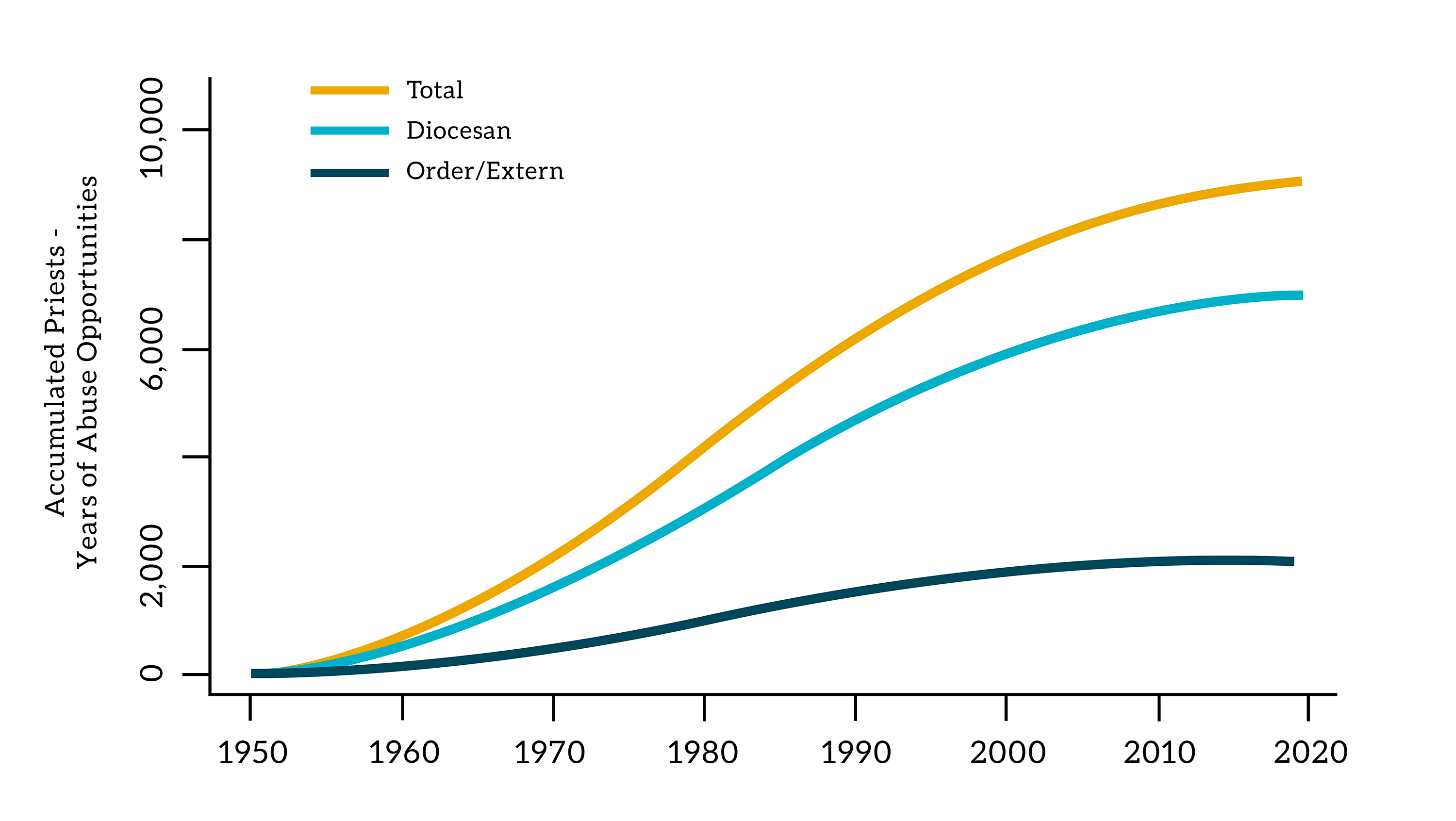
The next graphs break down the total cumulative years of abuse opportunities by diocese. The figures for each diocese also identify the tenures of bishops. Any flattening of the upward slope in these graphs marks when the number of abusers in the diocese was greatly reduced. Any complete flattening to a straight line indicates that all abusers were removed from the diocese and no new abusers were added. A reduction in abusers could come from abusers dying or leaving the priesthood or religious order voluntarily or involuntarily. But to achieve the drastic reduction needed to flatten the slope, bishops likely must have taken proactive measures to remove substantiated abusers from the priesthood and their diocese, or taken measures to ensure that child sex abuse does not occur at the outset. Therefore, these graphs depict whether, and when, each bishop actually flattened the upward slope showing accumulating years of opportunities for abuse through proactive measures, such as removing priests and brothers who are substantiated child sex abusers from their diocese.
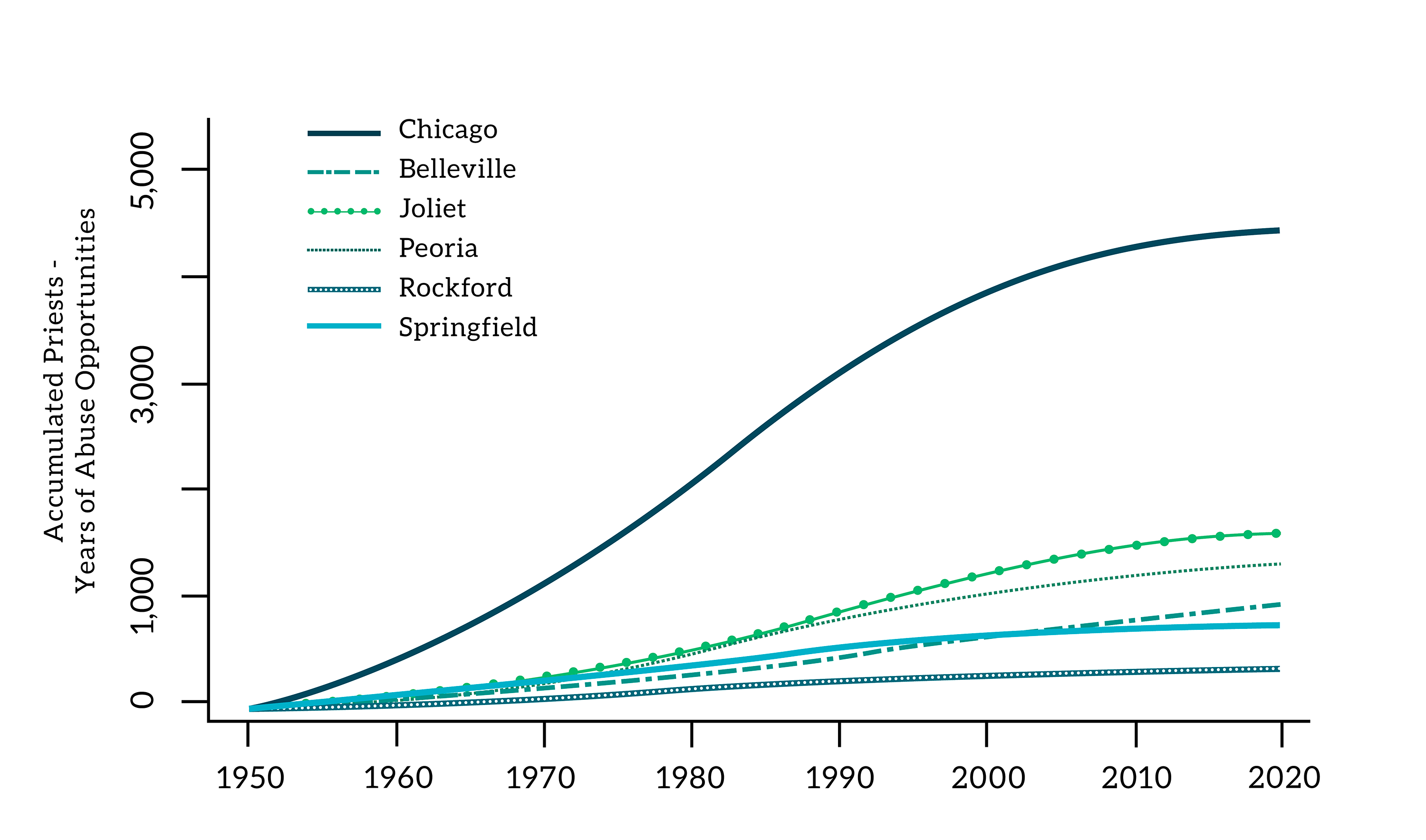
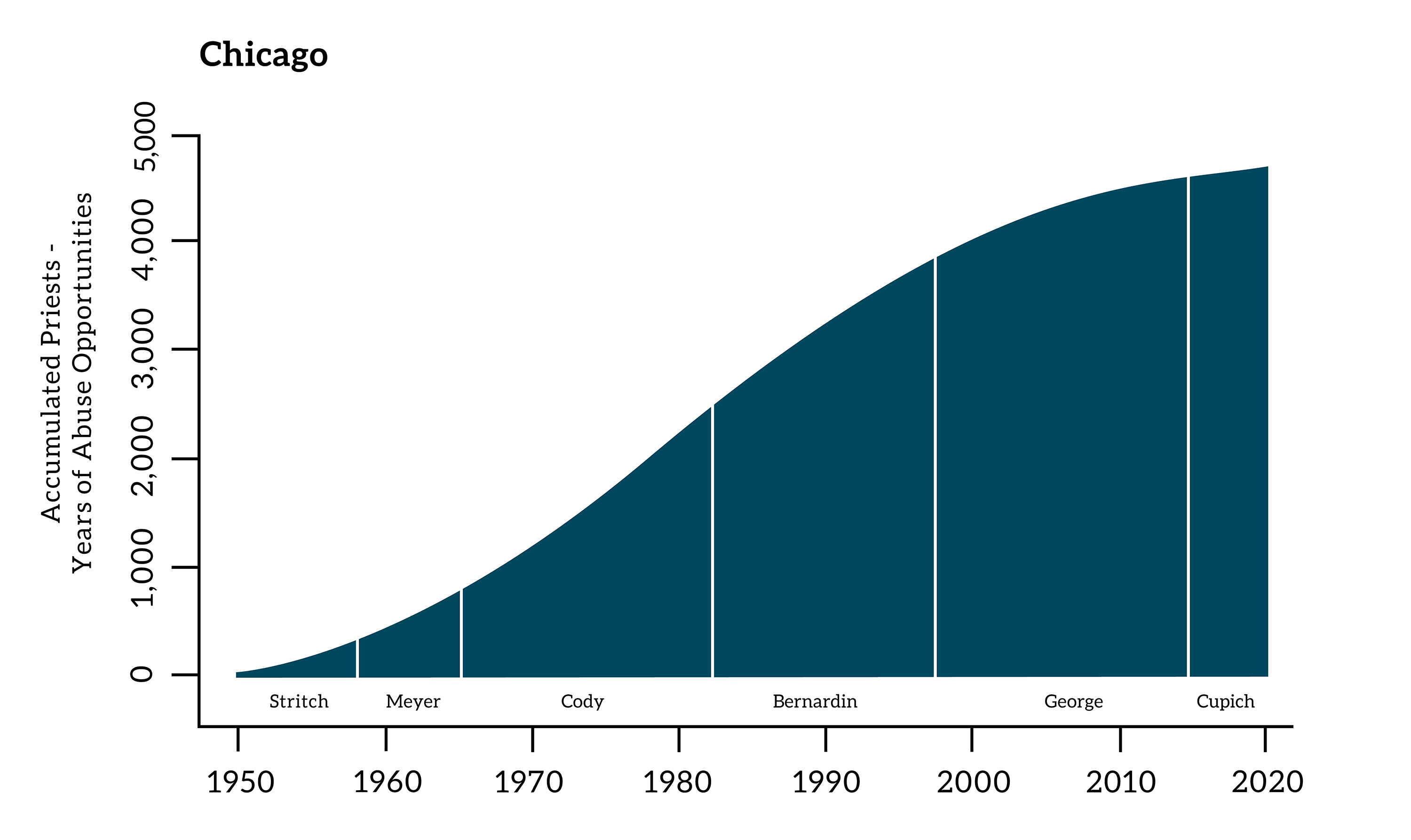
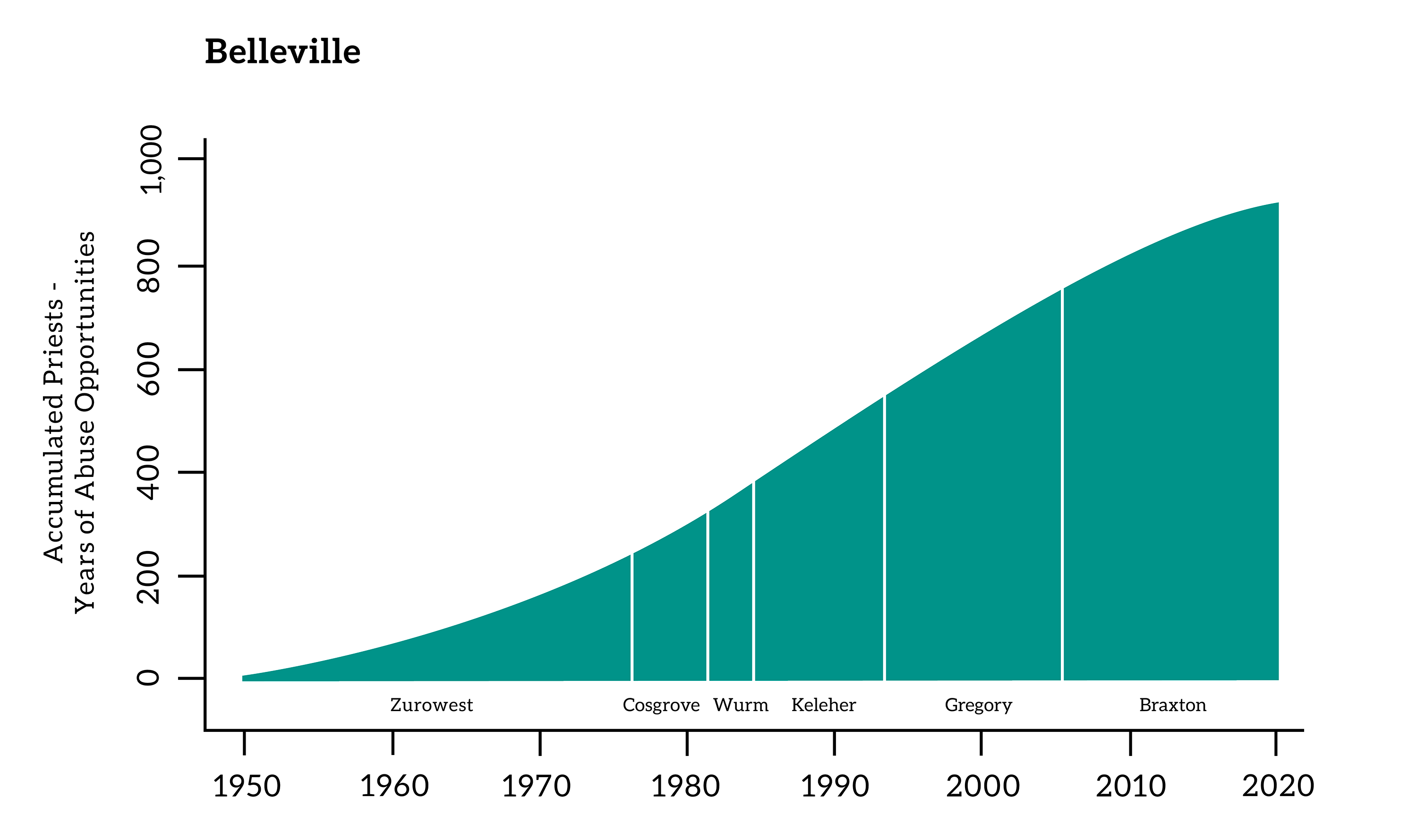
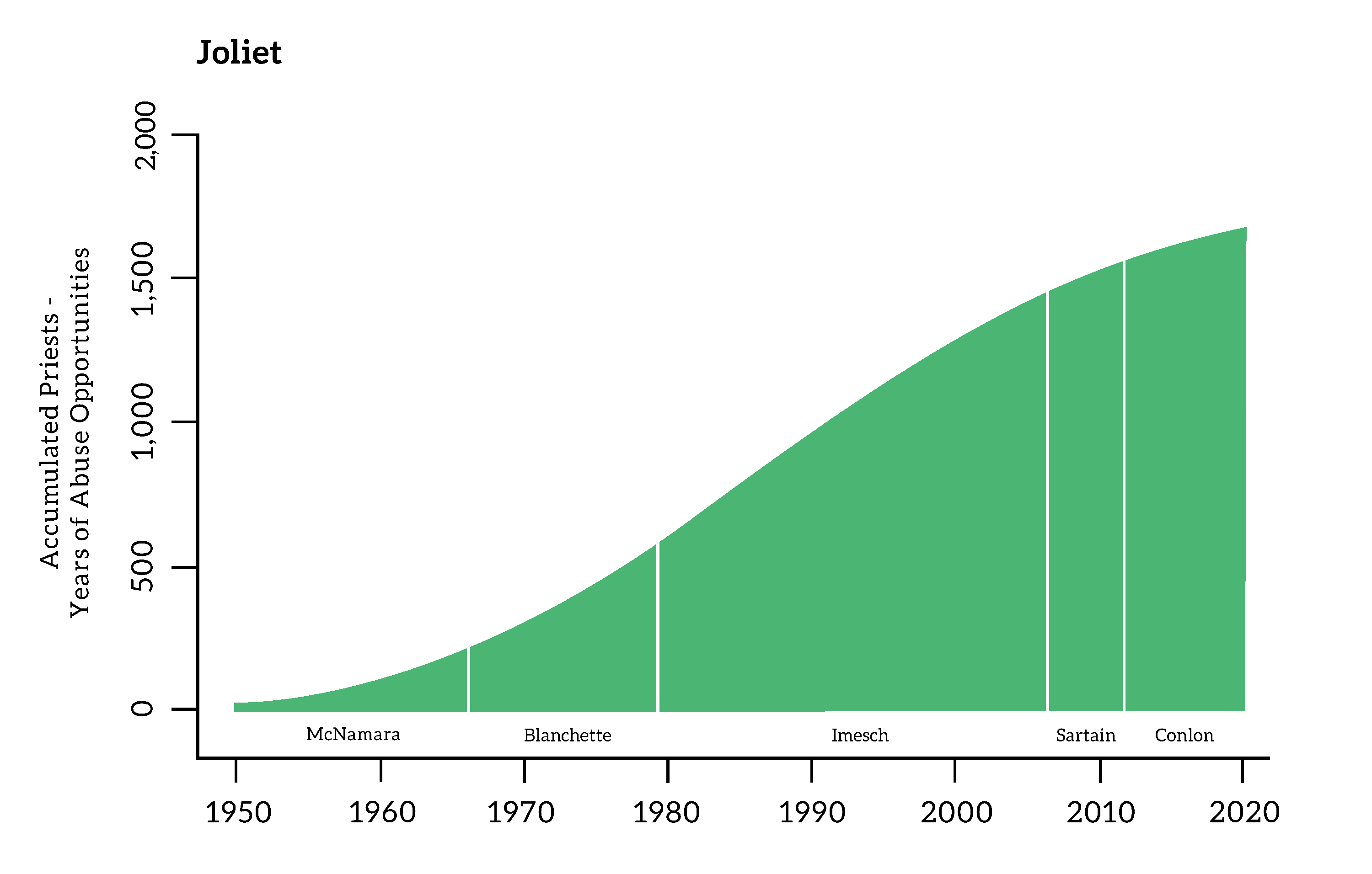
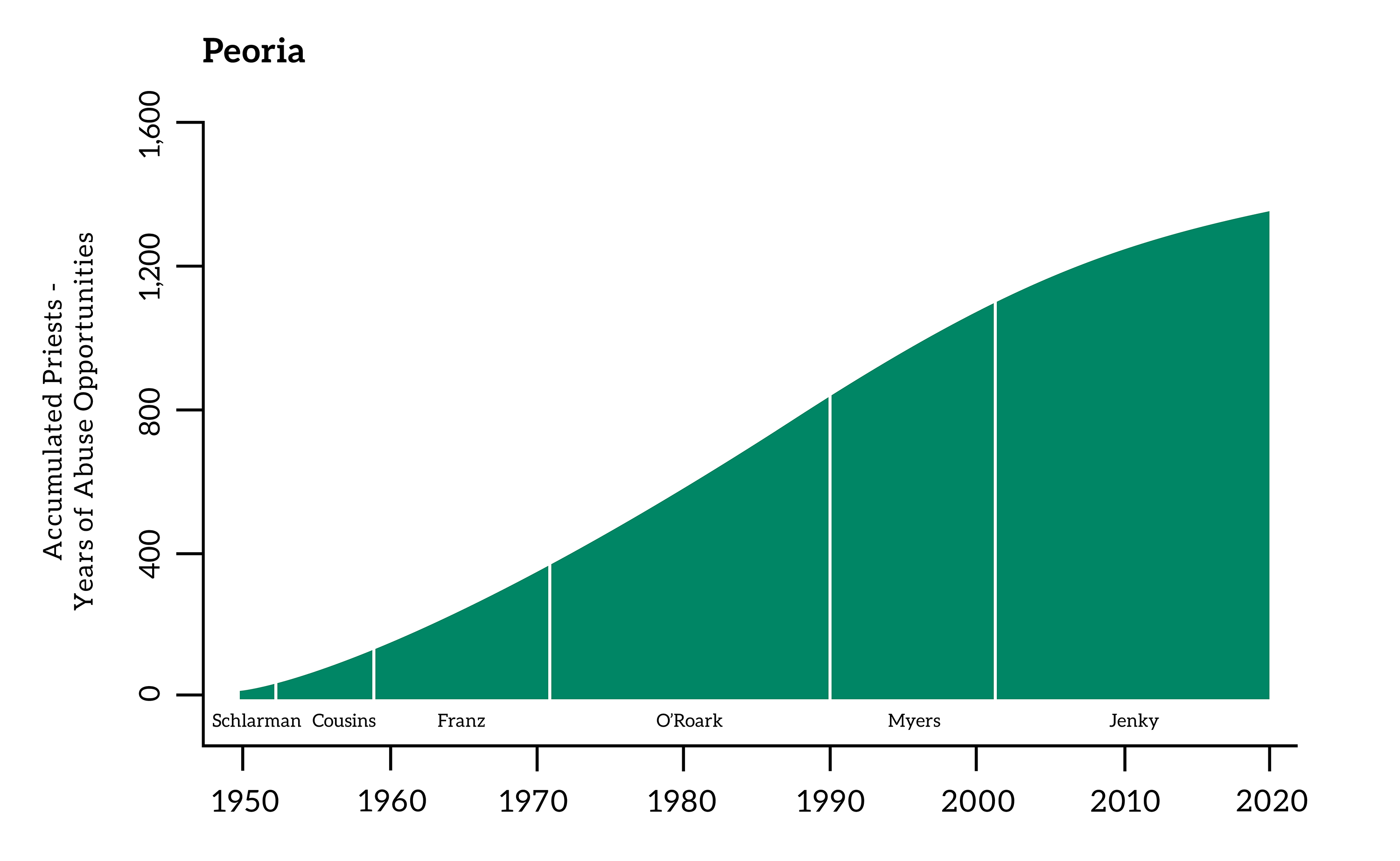
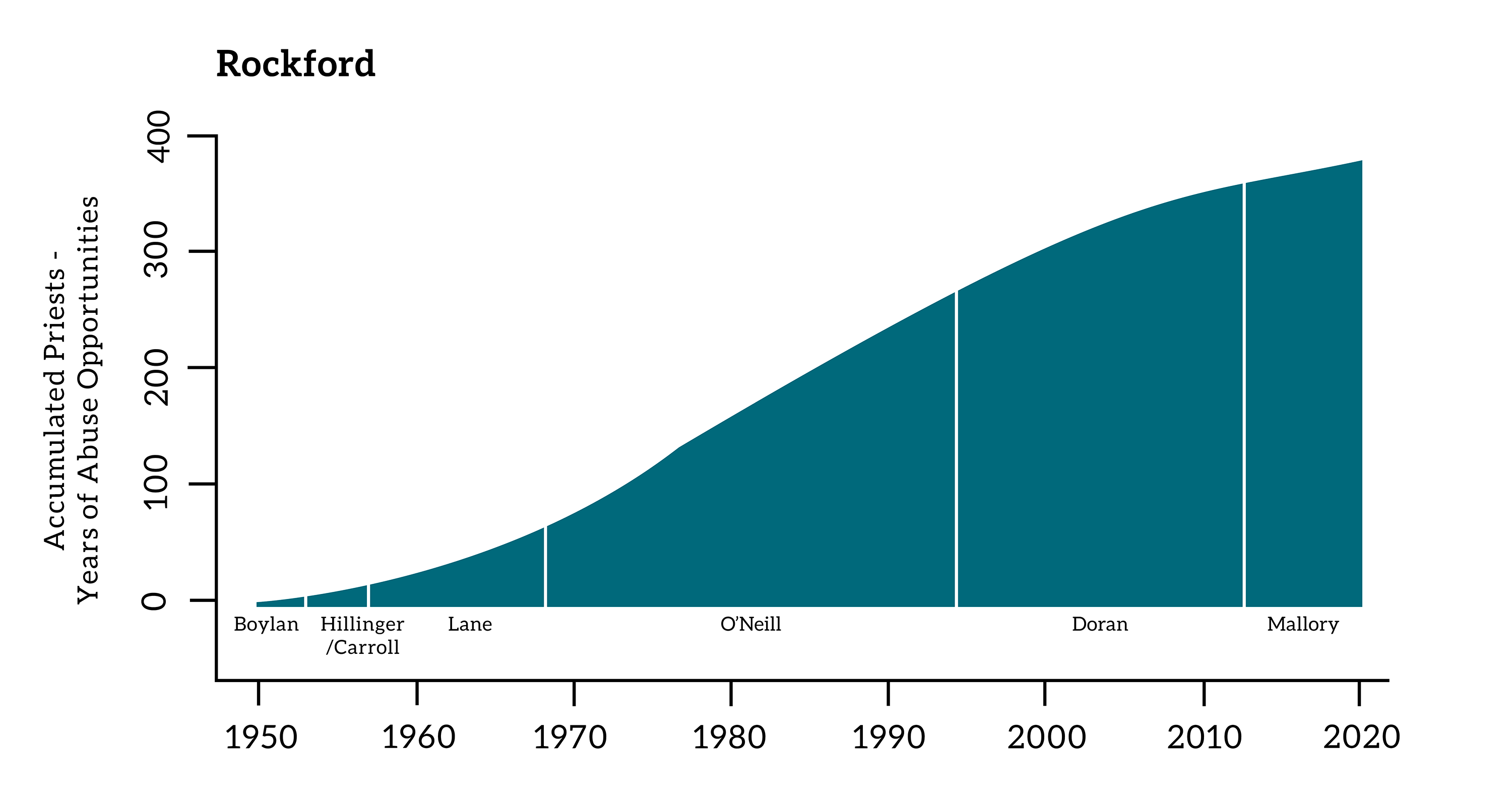
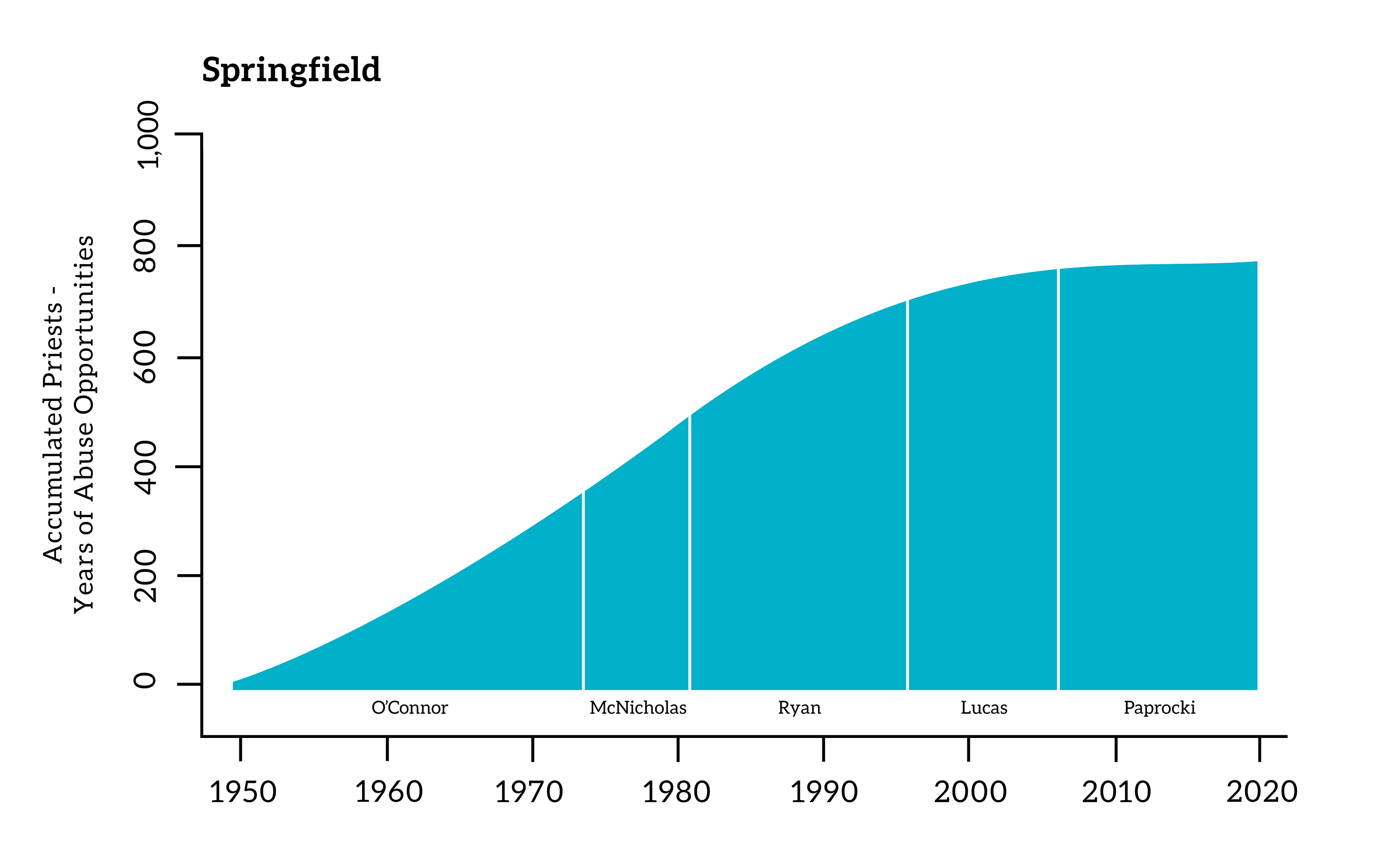
Percentage of Priests and Brothers That Are Substantiated Abusers
The following graphs reveal for each year the percentage of priests and brothers associated with an Illinois diocese who are substantiated child sex abusers, out of all priests and brothers associated with an Illinois diocese. Statewide, the percentage of abusers peaked at 4.8% in 1988. By 2019, that percentage had dropped to 1.5%.
In the 1990s in the Peoria, Joliet, and Belleville dioceses, more than 8% of their priests and religious brothers have been substantiated as child sex abusers. Even more alarming is that the Diocese of Belleville remained above 8% from 1991 through 2011, and even exceeded 10% in 2011. On the whole, from 1950 to 2002, the Archdiocese of Chicago and Diocese of Rockford had the lowest percentage of priests and brothers that are substantiated abusers, generally staying under 4% throughout this period.

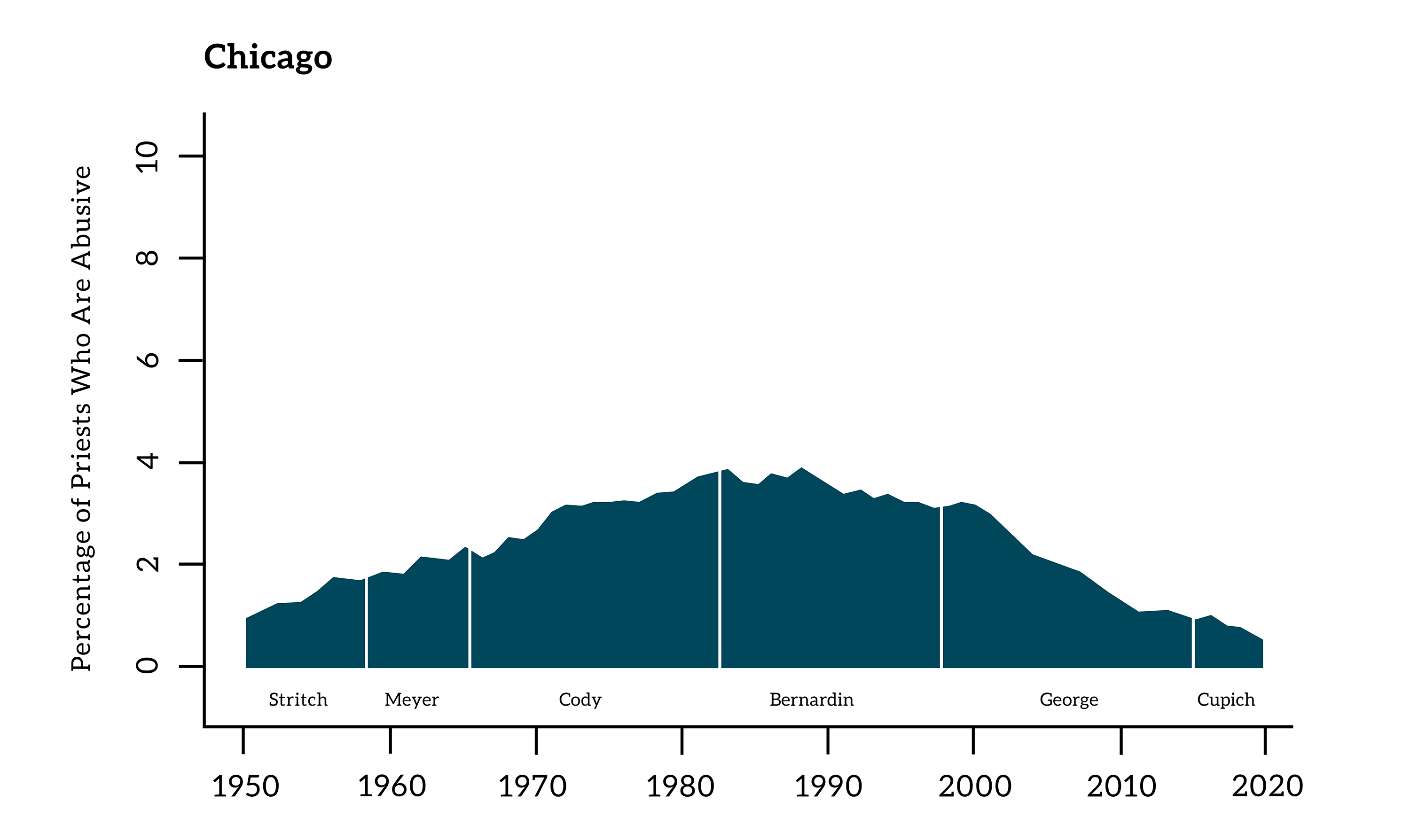
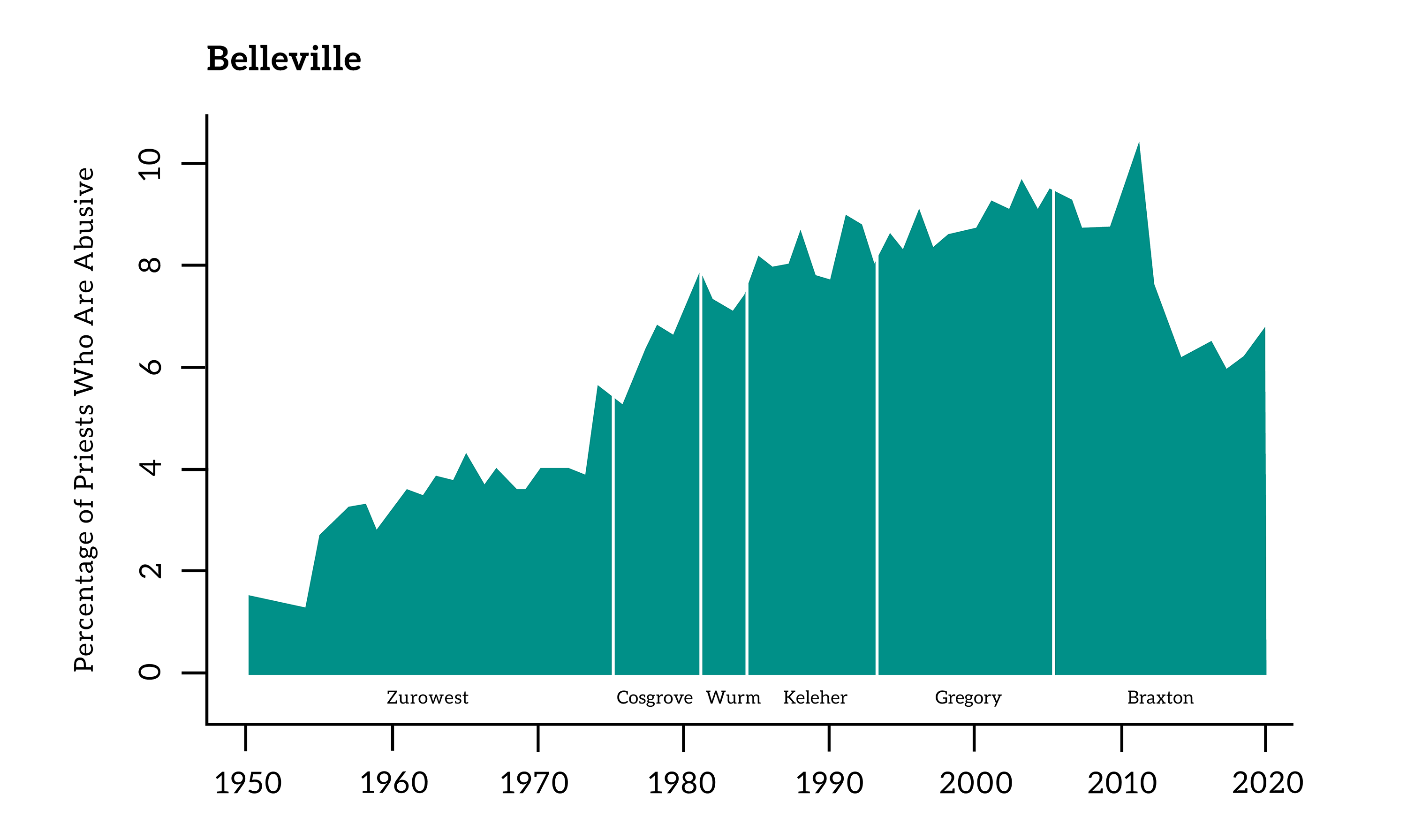
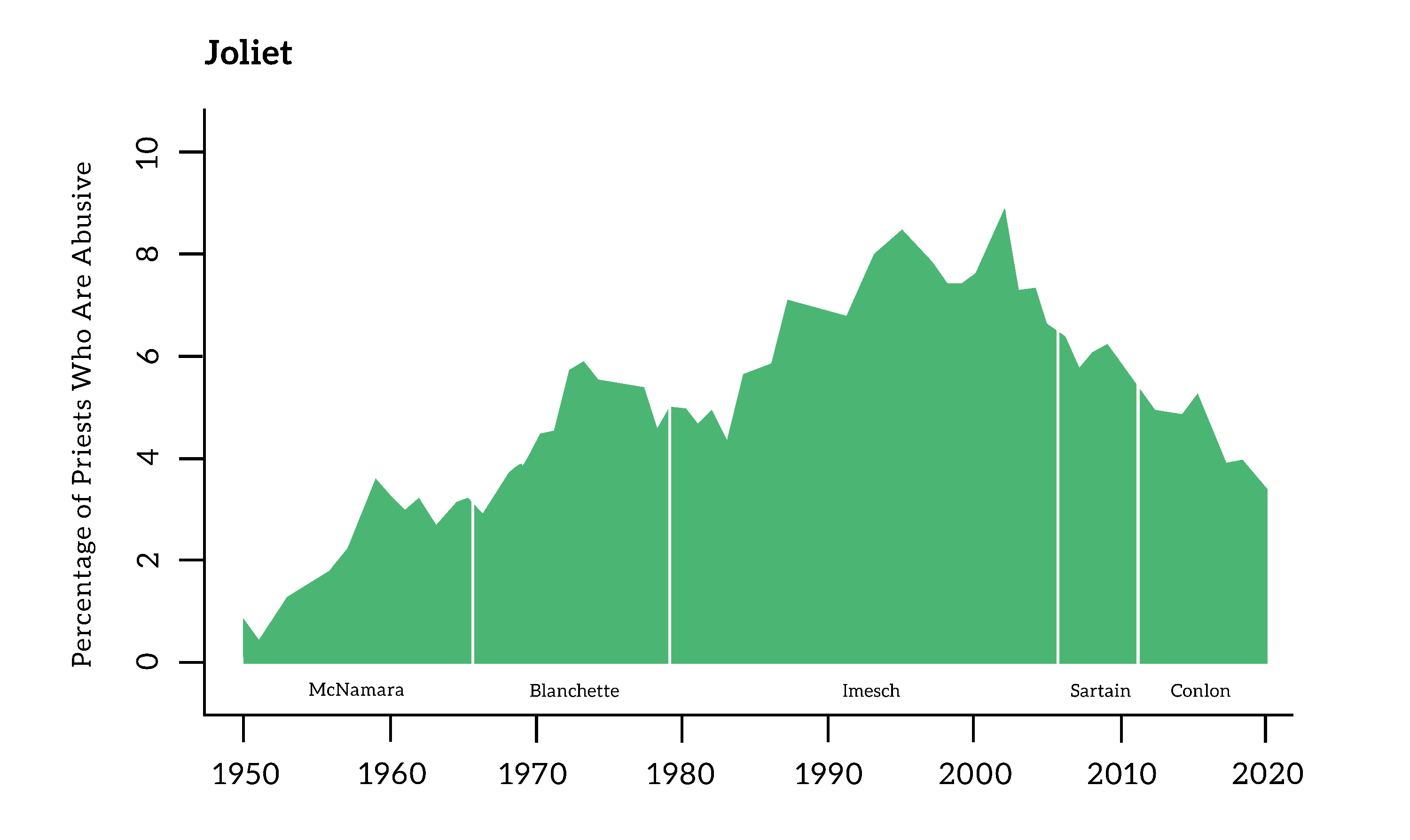
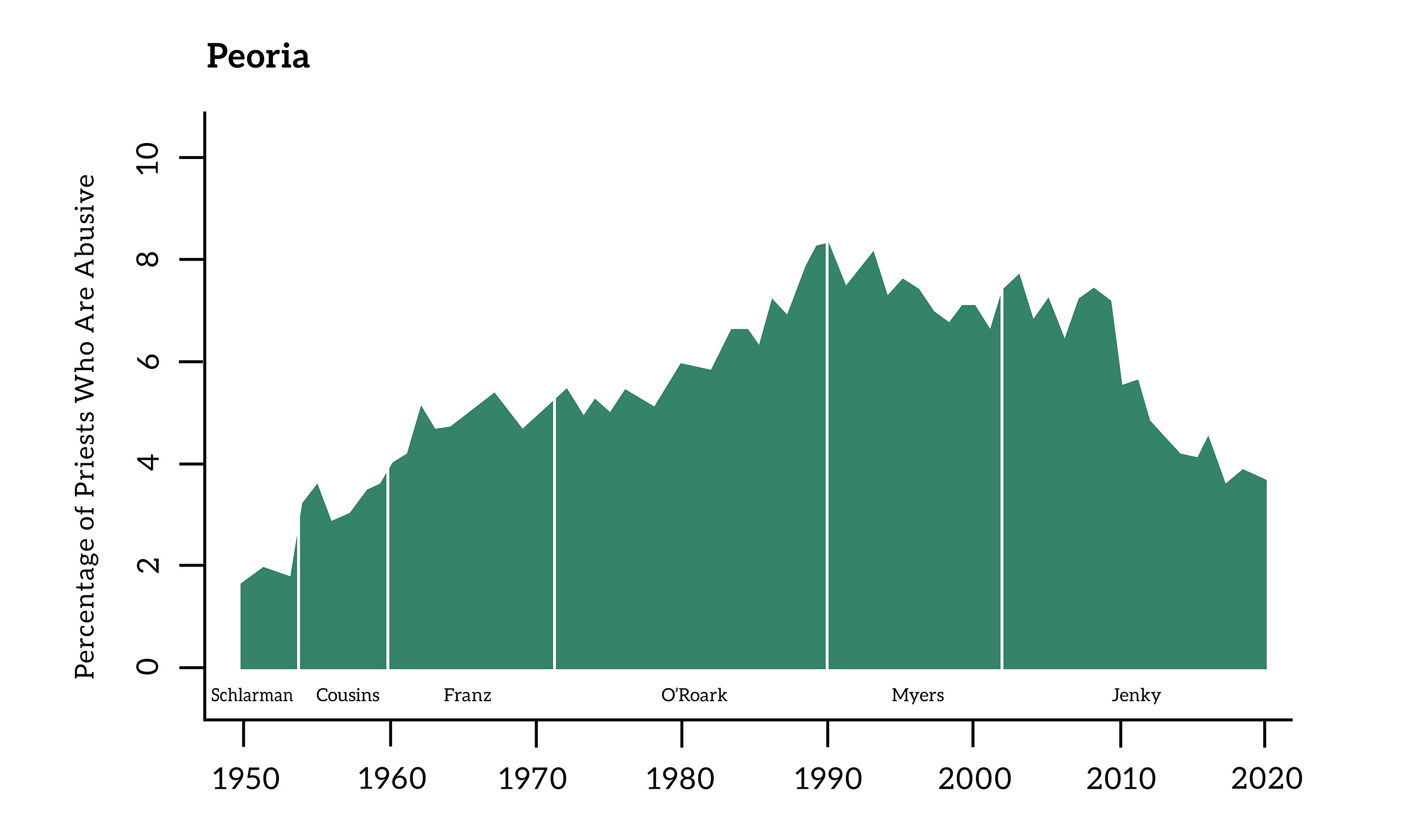
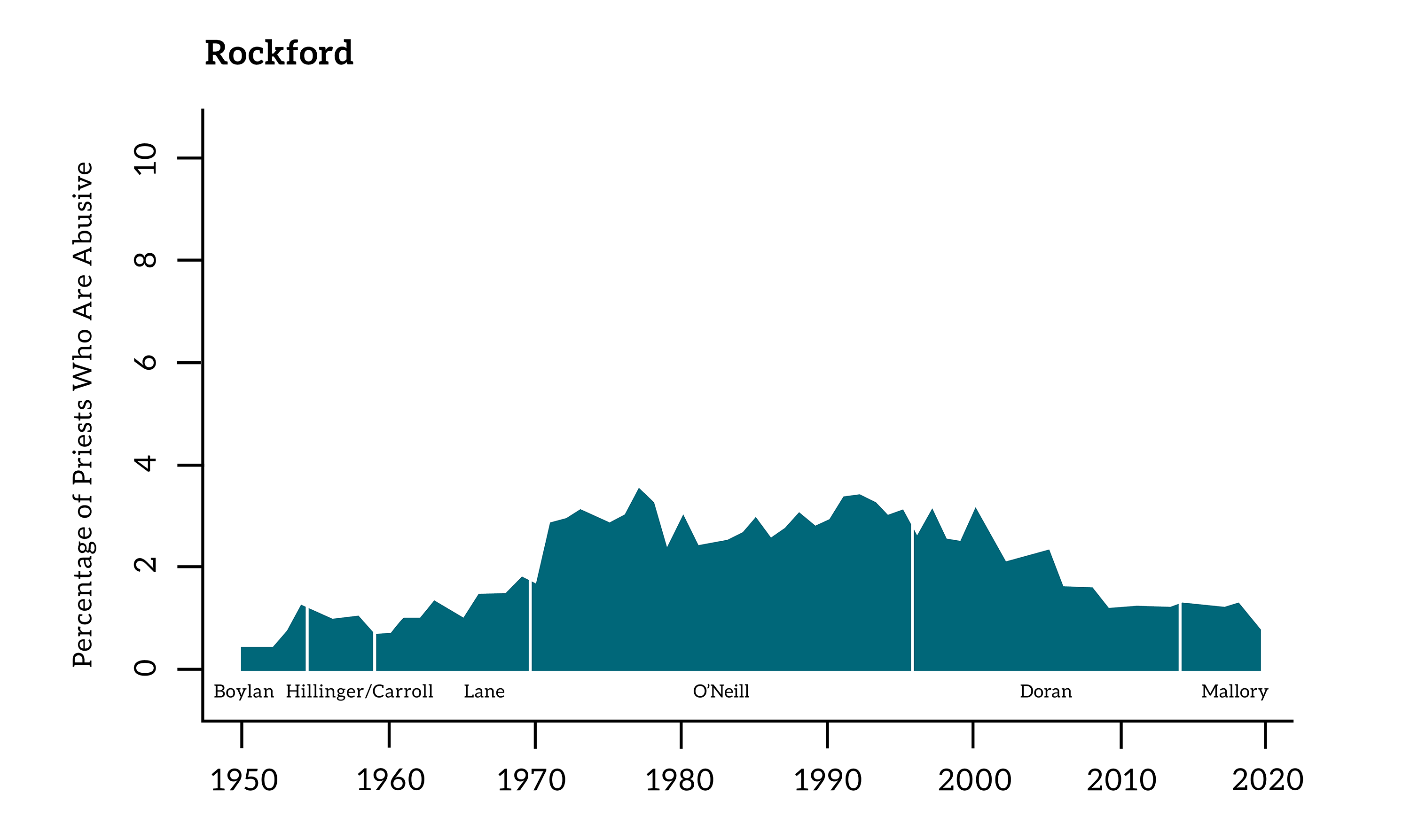
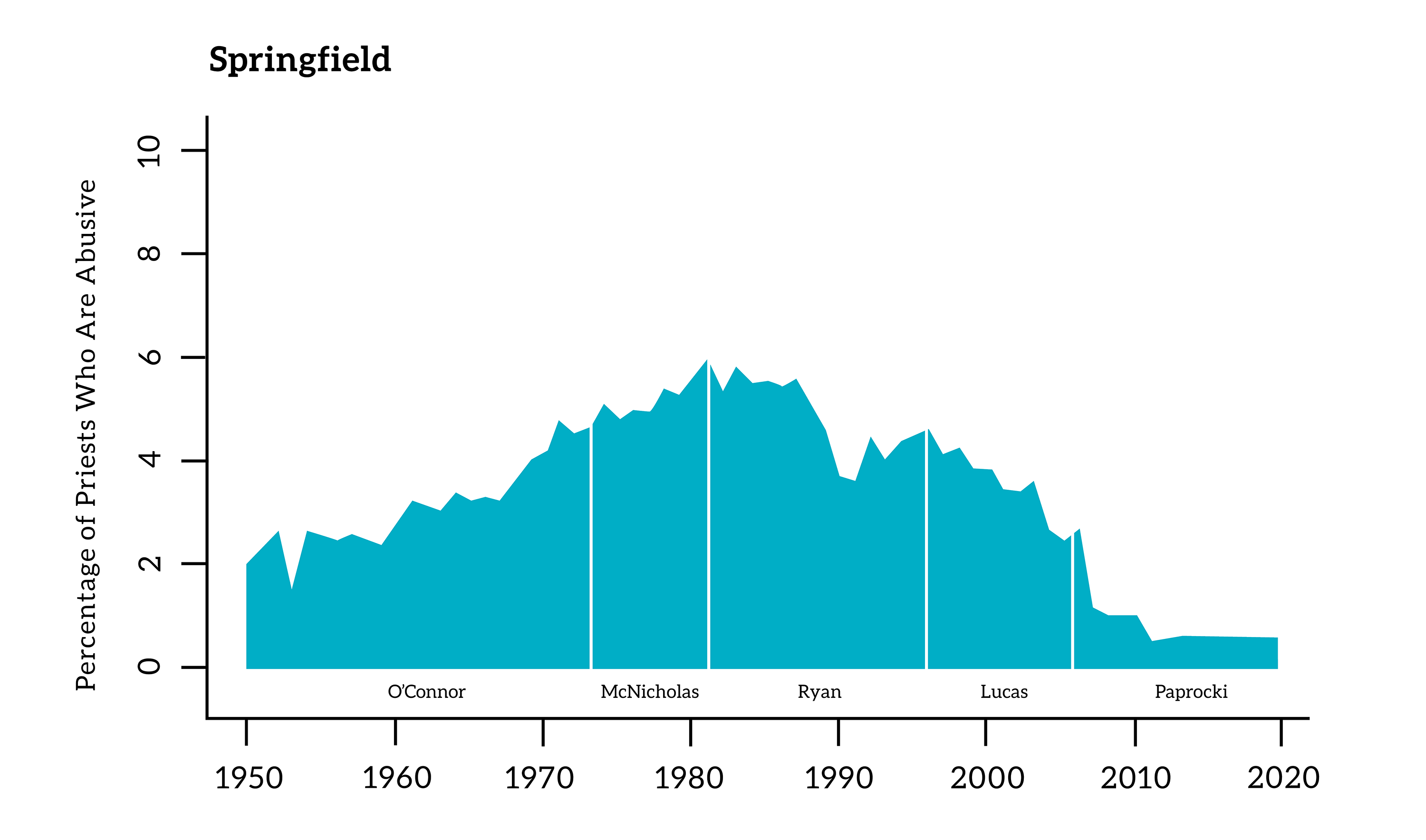
The Australian Royal Commission into Institutional Responses to Child Sexual Abuse, in its Final Report Religious Institutions, Volume 16: Book 1, page 35, employed a similar methodology as the Attorney General used here when assessing the proportion of Catholic clerics that sexually abused children in Australia. The Commission “calculated the proportion of” diocesan and religious order priests “who ministered in the period 1950 to 2010 who were alleged perpetrators, taking into account the duration of ministry (a weighted averaged methodology).” It concluded that “[o]f all Catholic priests included in the survey who ministered between 1950 and 2010, taking into account the duration of ministry, 7 percent were alleged perpetrators” (emphasis added). At page 295 of the same report, the Commission found that weighted average methodology was appropriate because “it properly took into account the risk to children and was the statistically appropriate methodology for calculating proportions over a period of six decades.” The Commission also concluded that such a methodology “ensured that a statistically consistent approach was taken to individuals who were in ministry for only a few years, and individuals who were in ministry for decades.”
John Jay Reports Commissioned by USCCB
The United States Conference of Catholic Bishops commissioned the John Jay College of Criminal Justice to conduct a research study into child sex abuse by Catholic clerics in 2002. The results of that study were published in two reports: the June 2004 report titled The Nature and Scope of Sexual Abuse of Minors by Catholic Priests and Deacons in the United States 1950-2002, and the May 2011 report titled The Causes and Context of Sexual Abuse of Minors by Catholic Priests in the United States, 1950-2010 (collectively, “John Jay Reports”). The John Jay Reports were the first of their kind in terms of cooperation with the Catholic Church, geographic scale, and studied time period. They remain the most comprehensive nationwide study on the issue, and are frequently cited by Catholic officials.
The John Jay Reports concluded that 3% to 6% of priests in all of the United States from 1950 to 2002 have an allegation of child sex abuse against them that Catholic officials deemed “not implausible.”[1] This statistic is primarily based on confidential surveys completed by Catholic dioceses and religious orders. The John Jay Reports did not publish the individual data collected from the Illinois Dioceses or any other dioceses or orders. In fact, all completed surveys were stripped of identifying information and destroyed after data entry. The Attorney General requested the data that the Illinois Dioceses provided to John Jay researchers in the surveys, but no diocese produced this data. In fact, all but one Illinois diocese represented to the Attorney General that they no longer possess their John Jay survey responses. Thus, there was no way for the Attorney General to analyze the Illinois Dioceses’ survey responses when investigators reviewed the dioceses’ files, or consider this data for the Attorney General’s data analysis. This lack of transparency is troubling considering Catholic officials’ ongoing reliance on the John Jay Reports.
For the total number of priests from 1950 to 2002, John Jay researchers relied on the diocese/order survey results and data from the Center for Applied Research in the Apostolate, a non-profit research center at Georgetown University. The John Jay survey asked dioceses and religious orders to provide the total number “of active and retired priests in the diocese/eparchy/religious community during the study period, 1950 – 2002.” John Jay researchers also looked at “estimates produced by” the Center for Applied Research in the Apostolate for 1960 to 1996 to ensure they had a reliable denominator for the total number of priests.[2] The Center for Applied Research in the Apostolate used the Directories in sourcing its data, just as the Attorney General did here.
For the total number of priest child sex abusers, the John Jay survey sought from dioceses and religious orders information on all “allegations” of child sex abuse that occurred from 1950 to 2002 made against priests in the diocese or order. The John Jay survey did not use the dictionary definition of “allegation”— “without proof or before proving.” Instead, it defined an “allegation” as “any accusation that is not implausible,” and in turn, defined “implausible” as an accusation “that could not possibly have happened under the given circumstances[.]”[3] Then, the dioceses and religious orders themselves determined whether an accusation of child sex abuse was “not implausible” and thus should be reported to John Jay researchers. Unlike the Attorney General, the John Jay team did “not itself have access to the confidential Church files,” but instead relied on dioceses and orders to review all of their own files for child sex abuse accusations against clergy and decide whether each accusation was “not implausible.”[4]
The self-reporting aspect of the John Jay data is problematic considering that, as illustrated in this report, over the course of years, the Illinois Dioceses have been overly skeptical of accusations of child sex abuse against a cleric, viewed such accusations in the light most favorable to the accused, and sought evidence to discredit the accuser. Further, other than the Archdiocese of Chicago and Diocese of Joliet, prior to 1992, the Illinois Dioceses generally lacked procedures for documenting allegations of child sex abuse and had poor recordkeeping practices for such allegations. For the Belleville, Peoria, and Springfield dioceses, documenting such allegations continued to be minimal up to the Attorney General’s initiation of this investigation. The Attorney General also learned from many survivors that they were discouraged from reporting child sex abuse by clerics to Catholic officials or feared revictimization in doing so, meaning that the Illinois Dioceses likely lacked any documentation of such survivors’ allegations for the John Jay surveys. Accordingly, the files that the Illinois Dioceses reviewed when completing the John Jay survey were questionable at best, and were certainly not representative of all claims of child sex abuse by a Catholic cleric in the Illinois Dioceses that have been deemed substantiated.
In addition to relying on incomplete information, the John Jay researchers also eliminated any allegation of child sex abuse by a cleric if “the alleged incident was prior to 1950 or after 2002.”[5] Thus, even if alleged abuse occurred in 1949 and the accused was still a priest in 2002, they were not counted as an abuser in the John Jay Report. In contrast, the Attorney General’s report is not limited to when child sex abuse occurred, but rather to when any substantiated abuser was a cleric or brother. Any substantiated child sex abuser who was a Catholic cleric or brother at any point from 1950 to 2019 fell within the purview of this report.
Despite compiling data from all 50 states in the Union across 52 years, the John Jay Reports did not analyze that data by particular state, diocese, or year. Rather, the researchers simply collapsed all data across geography and time, making it impossible for Catholic communities to hold their respective leaders accountable for child sex abuse by clerics that occurred in a specific diocese at a specific time. The closest the John Jay Reports came to localized data was charting it by the regions designated by the Catholic church. The Illinois Dioceses are in “Region 7,” which also includes all Indiana and Wisconsin dioceses. The John Jay Reports found that across Region 7, an average of 4 percent of clerics had been “not implausibly” accused of child sex abuse from 1950 to 2002.[6]
Around February 2004, just before the first John Jay Report was released, each of the Illinois Dioceses issued press statements on the scope of child sex abuse by clerics in their diocese. The Illinois Dioceses shared the number of abusers and total number of priests in their diocese, and cited the upcoming John Jay Report as their impetus for doing so. Some dioceses limited their data to local diocesan priests, while others tallied all priests and brothers (local diocesan priests, extern priests, and religious order priests and brothers) who served in the diocese. Using the number of “not implausible” abusers and whatever total number of priests/brothers each diocese chose, the dioceses announced the percentage of priests or clerics in their jurisdiction that were child sex abusers. Like the John Jay Reports and unlike the data analysis in this report, the Illinois Dioceses’ percentages did not account for how long abusers were priests or brothers or otherwise analyze the data by year. The below chart contains the percentages reported by the Illinois Dioceses around February 2004.
|
Diocese |
Percentage of Abusers from 1950-2002 as Reported by Diocese in Approx. February 2004 |
|
Belleville |
“Slightly less than 5%” of “priests who have served in this diocese” |
|
Chicago |
“About 2% of archdiocesan priests” |
|
Joliet |
“Approximately 3.5%” of “priests who have served in the Diocese of Joliet” |
|
Peoria |
0.02% of Peoria diocesan priests |
|
Rockford |
0.64% of “total clergy serving the Diocese” and 0.77% of “diocesan clergy service in the Diocese” |
|
Springfield |
3.29% of diocesan priests who served in the Diocese of Springfield |
The below chart compares the number of abusers reported by the Illinois Dioceses around February 2004 with the number of clerics and religious brothers that are substantiated child sex abusers contained in this report.
|
Diocese |
Number of Abusers from 1950-2002 Reported by Diocese in Approx. February 2004 |
Number of Clerics/Brothers Who Are Substantiated Child Sex Abusers Associated with Diocese from 1950-2019 as of April 2023 |
|
Belleville |
17 priests |
43 clerics and brothers |
|
Chicago |
55 archdiocesan priests |
275 clerics and brothers |
|
Joliet |
27 diocesan priests |
69 clerics and brothers |
|
Peoria |
14 diocesan priests |
51 clerics and brothers |
|
Rockford |
3 clergymen |
24 clerics and brothers |
|
Springfield |
14 diocesan priests |
32 clerics and brothers |
The John Jay Reports concluded:
Some bishops were “innovators” who offered organizational leadership to address the problems of sexual abuse of minors. Other bishops, often in dioceses where the Catholic Church was highly influential, were slow to recognize the importance of the problem of sexual abuse by priests or to respond to victims. The media often focused on these “laggards,” further perpetuating the image that the bishops as a group were not responding to the problem of sexual abuse of minors.[7]
Despite this recognition of significant differences in diocesan leadership by bishops, the John Jay Reports gave no other indication of who were “innovators” or “laggards.” Catholics have been left to guess which category their bishop falls into on an issue that puts the health and safety of children at risk. And nothing has prevented bishops from claiming that they are innovators and the media has merely painted them laggards, as described by the John Jay Reports. This is the opposite of transparency. On the other hand, to further the goals of justice, transparency, and healing, the data analysis in the Attorney General’s report shines a light on data outcomes of Illinois bishops’ leadership on child sex abuse by clerics and brothers.
A Research Study Conducted by the John Jay College of Criminal Justice the City University of New York, The Nature and Scope of Sexual Abuse of Minors by Catholic Priests and Deacons in the United States 1950-2002, June 2004, at 4.
Id. at 14, 27.
Id. at 20.
Id. at 13.
Id. at 26.
Id. at 30, Table 2.3.1.
Karen J. Terry et al., The Causes and Context of Sexual Abuse of Minors by Catholic Priests in the United States, 1950-2010, A Report Presented to the United States Conference of Catholic Bishops by the John Jay College Research Team, May 2011, at 4.
